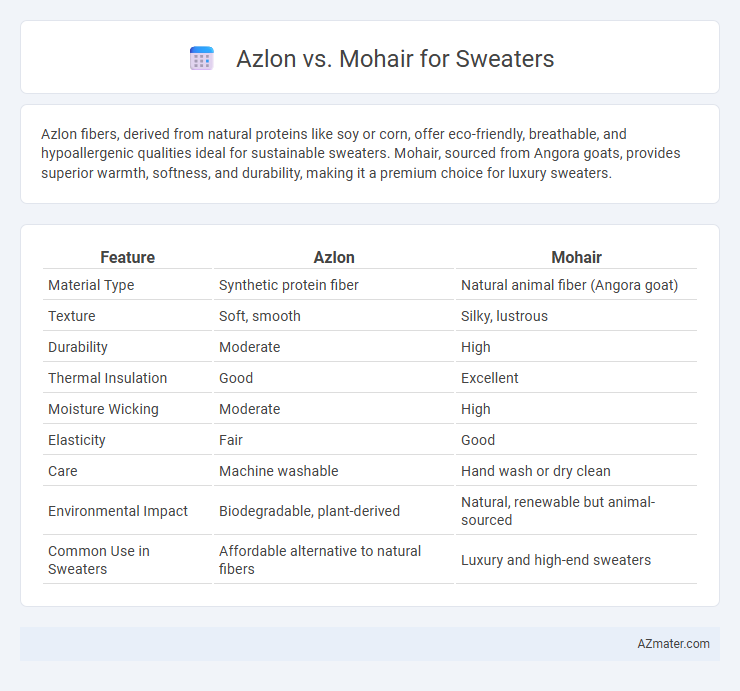Azlon fibers, derived from natural proteins like soy or corn, offer eco-friendly, breathable, and hypoallergenic qualities ideal for sustainable sweaters. Mohair, sourced from Angora goats, provides superior warmth, softness, and durability, making it a premium choice for luxury sweaters.
Table of Comparison
| Feature | Azlon | Mohair |
|---|---|---|
| Material Type | Synthetic protein fiber | Natural animal fiber (Angora goat) |
| Texture | Soft, smooth | Silky, lustrous |
| Durability | Moderate | High |
| Thermal Insulation | Good | Excellent |
| Moisture Wicking | Moderate | High |
| Elasticity | Fair | Good |
| Care | Machine washable | Hand wash or dry clean |
| Environmental Impact | Biodegradable, plant-derived | Natural, renewable but animal-sourced |
| Common Use in Sweaters | Affordable alternative to natural fibers | Luxury and high-end sweaters |
Introduction to Azlon and Mohair Sweaters
Azlon sweaters, made from regenerated protein fibers such as soy, milk, or corn, offer sustainable alternatives with natural moisture-wicking and softness properties. Mohair sweaters, derived from the hair of the Angora goat, are prized for their luxurious sheen, warmth, and durability. Both fibers provide unique textures and thermal insulation, making them popular choices in premium knitwear.
Origin and Production of Azlon
Azlon fibers are synthetic proteins derived from natural sources such as soy, corn, and milk, produced through processes that transform plant-based or animal-based proteins into fibrous materials suitable for textiles. Originating as a sustainable alternative to animal fibers, Azlon production emphasizes eco-friendly manufacturing methods and biodegradable end products. Mohair, on the other hand, comes from the Angora goat, valued for its silky texture and durability, whereas Azlon represents innovation in creating fibers with similar softness but enhanced environmental benefits.
Source and Characteristics of Mohair
Mohair, sourced from the Angora goat, is renowned for its silky texture, natural sheen, and excellent insulation properties, making it a luxurious choice for sweaters. It exhibits high durability, moisture-wicking capabilities, and resistance to wrinkles, distinguishing it from Azlon, a synthetic fiber derived from renewable plant proteins. Mohair's unique blend of softness and strength provides warmth without weight, ideal for high-quality knitwear.
Texture and Feel: Azlon vs Mohair
Azlon fibers offer a smooth, lightweight texture with a soft, breathable feel, making them ideal for comfortable, hypoallergenic sweaters. Mohair provides a luxurious, silky sheen combined with a slightly fuzzy surface that adds warmth and a plush touch to sweater fabrics. The choice between Azlon and Mohair significantly impacts the sweater's texture, with Azlon leaning towards sleek softness and Mohair delivering a richer, textured warmth.
Warmth and Insulation Comparison
Azlon fibers, derived from regenerated protein polymers, offer moderate warmth and breathability, making them suitable for lightweight sweaters with natural moisture-wicking properties. Mohair, sourced from the Angora goat, provides superior insulation and exceptional warmth due to its dense, fine fibers and natural loft, effectively trapping heat in colder conditions. When comparing warmth and insulation, mohair outperforms azlon by retaining body heat more efficiently while still maintaining softness and durability.
Durability and Longevity
Azlon fibers, derived from natural proteins like soy or milk, offer excellent durability due to their resistance to pilling and retaining shape over time, making them ideal for sweaters that require long-lasting wear. Mohair, sourced from the Angora goat, provides exceptional longevity with its strong, resilient fibers that resist wrinkling and maintain warmth, though it may require more delicate care to prevent damage. Both materials excel in creating durable sweaters, but Azlon's synthetic blend offers enhanced strength while mohair's natural elasticity supports extended garment lifespan.
Care and Maintenance Guidelines
Azlon sweaters, made from regenerated protein fibers, require gentle hand washing in cold water and air drying to prevent shrinking and damage. Mohair sweaters, derived from the Angora goat, demand delicate care including dry cleaning or mild hand washing with a specialized wool detergent to maintain softness and reduce pilling. Both fibers benefit from storage in cool, dry places away from direct sunlight and moth repellents to extend garment longevity.
Environmental Impact and Sustainability
Azlon fibers, derived from renewable plant or fungal sources, offer a more sustainable alternative to mohair, which comes from the Angora goat and involves intensive land use and water consumption. Mohair production can contribute to overgrazing and habitat degradation, whereas Azlon's biodegradable nature and lower resource requirements reduce environmental impact significantly. Choosing Azlon for sweaters supports eco-friendly fashion by minimizing carbon footprint and promoting renewable raw materials.
Price and Affordability Analysis
Azlon sweaters, made from regenerated protein fibers like soy or milk, generally offer a more affordable price point compared to mohair, which is sourced from Angora goats and tends to be more expensive due to its luxury status and labor-intensive harvesting. Mohair's higher cost reflects its superior sheen, durability, and insulation properties, appealing to premium markets, while Azlon provides a cost-effective, sustainable alternative with reasonable warmth and softness. Consumers prioritizing budget-friendly options often choose Azlon sweaters, whereas those seeking long-lasting luxury invest in higher-priced mohair garments.
Choosing Between Azlon and Mohair Sweaters
Azlon sweaters offer a sustainable alternative to mohair with their plant-based fibers, making them ideal for eco-conscious consumers seeking softness and durability. Mohair sweaters, derived from the Angora goat, provide exceptional warmth and a luxurious, silky texture but require more specialized care. When choosing between azlon and mohair sweaters, consider factors like allergen sensitivity, environmental impact, and maintenance preferences to select the best fit for your wardrobe.

Infographic: Azlon vs Mohair for Sweater
 azmater.com
azmater.com